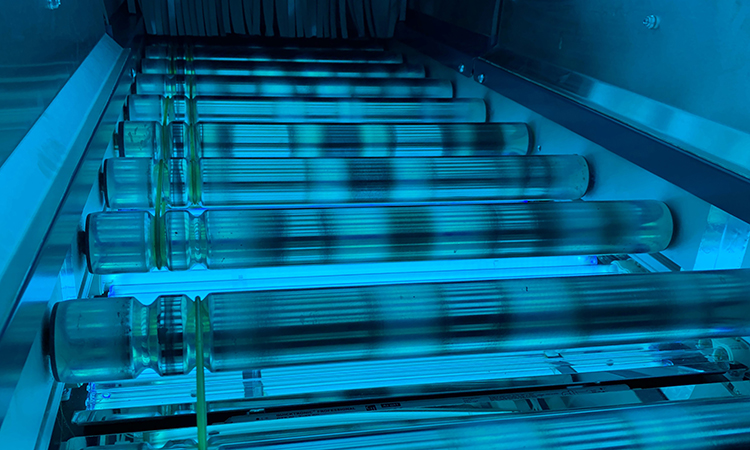Gatwick’s new technology has a 99.9 per cent microbe disinfection rate
- Like
- Digg
- Del
- Tumblr
- VKontakte
- Buffer
- Love This
- Odnoklassniki
- Meneame
- Blogger
- Amazon
- Yahoo Mail
- Gmail
- AOL
- Newsvine
- HackerNews
- Evernote
- MySpace
- Mail.ru
- Viadeo
- Line
- Comments
- Yummly
- SMS
- Viber
- Telegram
- Subscribe
- Skype
- Facebook Messenger
- Kakao
- LiveJournal
- Yammer
- Edgar
- Fintel
- Mix
- Instapaper
- Copy Link
Posted: 16 October 2020 | Abhi Chacko | No comments yet
Abhi Chacko, Head of Innovation and Commercial IT Services at London Gatwick Airport, discusses how deploying UV treatment of security trays will help restore consumer confidence.


Innovation is thriving in the COVID-19 world, from the fast-track development of vaccines and treatments to the implementation of new ways of living and working that protect against the onward spread of the virus.
Airports are no exception and, by going above and beyond standard health guidelines, airports can give passengers extra reassurance and help restore consumer confidence in flying. This is particularly important as we look likely to be living with – and be conscious of – viruses for some time to come, even with vaccines and new treatments in place.
Anti-viral systems at Gatwick Airport
Like other airports, Gatwick deployed a range of anti-viral systems across passenger and staff‑facing areas, including spraying security trays; a high‑touchpoint where there is a recognised risk of passing on infection.
The established spray coating protection dissipates over time however, so Gatwick trialled a new system that treats every tray just before every passenger or staff member uses it – ensuring maximum protection and a reduced risk of passing on infection.
Ultra-violet technology
Smith’s Detection Ultraviolet (UV) Light Upgrade Kits reduce the transmission of bacteria and viruses by automatically disinfecting checkpoint trays when they pass through a covered ‘UV-tunnel’ fixed underneath the hand luggage screening system.
The ultraviolet germicidal irradiation used in the process has been deployed in disinfection applications for over 100 years, often in medical sanitation and sterile work facilities with high-hygiene requirements.
Gatwick leveraged this technology for tray disinfection, with low pressure mercury bulbs emitting short wavelength ultraviolet C light to kill or inactivate microorganisms by disrupting their DNA or RNA, leaving them unable to perform vital cellular functions. Boston University recently validated the effectiveness of UV lamps in killing COVID-19.
The kits are also safely shielded from any UV leakage using robust metal housing and by closely following relevant safety standards and – following a one month trial on a single security lane in July 2020 and laboratory tests demonstrating a 99.9 per cent microbe disinfection rate – the new system was rolled out on eight lanes, six for passengers and two for staff, in Gatwick’s North Terminal at the end of September 2020.
Results from the trial also showed the system to be extremely reliable, providing a high degree of reassurance – as every passenger can now use a tray that has just been disinfected – and that the system did not slow down that security screening process.
Responding to COVID-19
Other health measures in place at Gatwick include: The frequent, enhanced deep cleaning of common-use surfaces throughout the airport; the installation of approximately 500 perspex screens; social distancing procedures at check in, security, gate rooms, seating in departure halls and in restaurants, bars and shops; ample, well signposted hand washing facilities; and around 200 sanitising stations.
All passengers are also advised to bring and wear their own face covering throughout the airport.
The introduction of the UV-C kits demonstrates Gatwick’s interest in ensuring the highest standard of care for passengers and staff in response to COVID-19. As an airport, it is important that we continue to explore innovative health solutions like this that reduce the spread of coronaviruses and other infections, not least to restore consumer confidence, which will be vital for our industry’s recovery going forward.
Additional trials and innovation at Gatwick Airport
London Gatwick Airport has also trialled a new ECAC EDS CB C3 approved computed tomography cabin baggage screening system; enhancing the passenger journey. CT technology offers a number of advantages to security screening processes at airports, including minimising the time passengers spend in line with other travellers and decreasing the level of contact between passengers, screeners and surfaces, such as trays.
Allowing liquids and laptops to be left in bags during screening, the HI-SCAN 6040 CTiX not only increases operational efficiency and passenger throughput, but also reduces the number of touchpoints and, therefore, the risk of virus transmission.
The data richness of volumetric CT technology enables the systems to make very precise decisions about baggage contents and, as a result, the best can deliver a false alarm rate as low as five per cent. This will be fundamental to reducing the number of secondary screenings – requiring close interaction of screeners with passengers and their belongings – and will further increase passenger throughput, which will positively impact personal space.
Abhi Chacko is Head of Innovation and Commercial IT Services at Gatwick Airport, and is accountable for providing IT services to airlines, ground handlers and airport tenants, as well as for driving tech‑led innovation for the campus. With more than 20 years of experience, he has led several industry-first initiatives at Gatwick, such as the award-winning Airport Community App, machine learning for predicting flight departure times, airport chatbots and a beacon-based indoor navigation system.
Issue
Related topics
Airport crisis management, Airside operations, COVID-19, Passenger experience and seamless travel, Safety, Security, Terminal operations


















